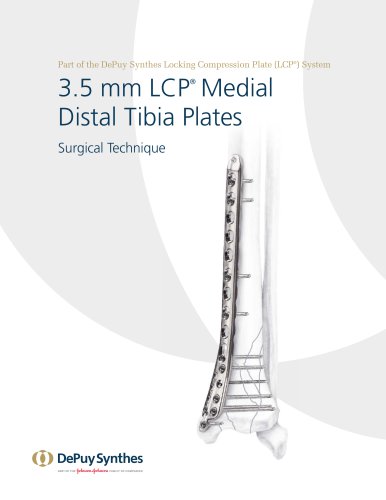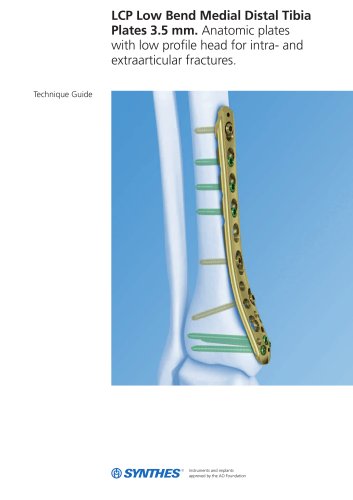 Website:
Depuy Synthes
Website:
Depuy Synthes
Group: Johnson & Johnson
Catalog excerpts

This publication is not intended for distribution in the USA. SURGICAL TECHNIQUE
Open the catalog to page 1
INTRODUCTION S-ROM NOILES Rotating Hinge Knee System 2 SURGICAL TECHNIQUE Initial Preparation of the Tibia 4 Preparation of the Metaphyseal Bone - Tapered Reamer 6 Proximal Tibial Resection - Tapered Reamer 7 Preparation of the Metaphyseal Bone - Broach 9 Final Preparation of the Tibia 10 Preparation of the Femoral Diaphysis 11 Reaming the Medullary Canal 12 Preparation of the Metaphysis (for Sleeve Use) 14 Femoral Anterior, Chamfer, and Box Cuts 20 APPENDIX Cemented Tibial Stem Preparation 35 Step Wedge Preparation 38 Thick Tray Preparation...
Open the catalog to page 3
The S-ROM NOILES Rotating Hinge features: • S-ROM Femoral Components available in three sizes • Seven degree physiological valgus, fixed in the femoral component • Deep femoral trochlear groove • Modular textured sleeves to accommodate bone defects of the Engh Type II and Type III classification* and allow possible bone ingrowth • Slotted tibial and femoral stems to enhance torsional stability and fixation into intact medullary bone1 • Broad, congruent contact areas between femoral and tibial components to best distribute surface and subsurface stresses in the polyethylene • A rotating...
Open the catalog to page 4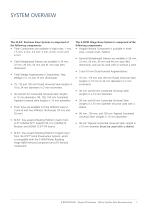
The M.B.T. Revision Knee System is comprised of the following components: • Tibial Components are available in eight sizes, 1 mm, 1.5 mm, 2 mm, 2.5 mm, 3 mm, 4 mm, 5 mm and 6 mm • Tibial Metaphyseal Sleeves are available in 29 mm, 37 mm, 45 mm, 53 mm and 61 mm sizes (M/L dimension) • Tibial Wedge Augmentation Components: Step Wedge in 5, 10 and 15 mm thicknesses • 75, 115 and 150 mm Fluted Universal Stem lengths in 10 to 24 mm diameters in 2 mm increments • 30 and 60 mm Cemented Universal Stem lengths in 13 mm diameters. 90, 120, 150 mm Cemented Tapered Universal stem lengths in 13 mm...
Open the catalog to page 5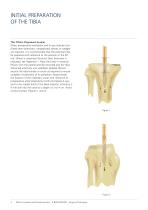
INITIAL PREPARATION OF THE TIBIA The Tibial Alignment System When preoperative evaluation and X-rays indicate that fluted stem extensions, metaphyseal sleeves or wedges are required, it is recommended that the proximal tibia be prepared with reference to the position of the IM rod. Where a cemented Universal Stem Extension is indicated, see Appendix 1. Place the knee in maximal flexion with the patella laterally retracted and the tibia distracted anteriorly and stabilised. Release fibrosis around the tibial border or excise as required to ensure complete visualisation of its periphery....
Open the catalog to page 6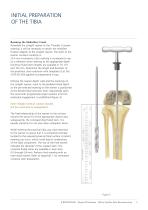
INITIAL PREPARATION OF THE TIBIA Reaming the Medullary Canal Assemble the straight reamer to the T-handle. If power reaming, it will be necessary to attach the modified Hudson adapter to the straight reamer. The shaft of the reamer contains markings in 25.4 mm increments. Each marking is numbered to use as a reference when reaming to the appropriate depth. Universal fluted stem lengths are available in 75, 115 and 150 mm. Determine the length and diameter of the prosthetic stem extension with templates (Cat. No. 2178-30-100) applied to preoperative X-rays. Utilising the reamer depth scale...
Open the catalog to page 7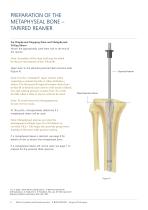
PREPARATION OF THE METAPHYSEAL BONE – TAPERED REAMER For Diaphyseal Engaging Stem and Metaphyseal Filling Sleeve Attach the appropriately sized stem trial to the end of the reamer. Note: Assembly of the stem trial may be aided by the pre-attachment of the T-handle. Taper ream to the planned proximal tibial resection level (Figure 4). Note: Use the “cemented” taper reamer when requiring a cement mantle or when utilising a sleeve. Use the press-fit tapered reamer when lineto-line fit is desired and a sleeve will not be utilised. Use end-cutting primary reamer (Cat. No. 217863-199) when a stem...
Open the catalog to page 8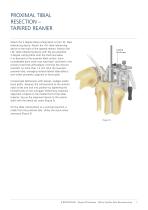
PROXIMAL TIBIAL RESECTION – TAPERED REAMER Attach the 2 degree tibial cutting block to the I.M. tibial referencing device. Attach the I.M. tibial referencing device to the shaft of the tapered reamer. Position the I.M. tibial referencing device with the pre-attached 2 degree cutting block onto the shaft and allow it to descend to the proximal tibial surface. Since considerable bone stock may have been sacrificed in the primary total knee arthroplasty, minimise the amount resected: no more than 1-2 mm from the resected proximal tibia, managing residual lateral tibial defects with either...
Open the catalog to page 9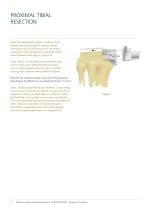
PROXIMAL TIBIAL RESECTION Note: If a metaphyseal sleeve is to be used, tibial resection using the 2 degree tibial cutting device is unnecessary as the tibial resection will be performed using the tibial sleeve broach. (see page 9, Figure 8) Note: There is a slotted and non-slotted end to the stylus. The difference between the two is 5 mm. Remove the I.M. device while leaving the 2 degree cutting block in place. Remove the tapered reamer and resect the proximal tibia (Figure 6) (Maximum saw blade thickness 1.5 mm). Note: At this point determine whether a step wedge is necessary on either the...
Open the catalog to page 10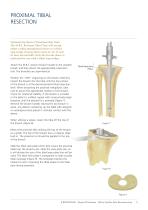
PROXIMAL TIBIAL RESECTION Optional For Sleeve Utilisation Only Note: The M.B.T. Revision Tibial Tray will accept either a tibial metaphyseal sleeve or a tibial step wedge if using sleeve sizes 37, 45, 53 and 61 mm, but not both. Only the 29 mm sleeve is indicated for use with a tibial step wedge. Attach the M.B.T. revision broach handle to the smallest broach and then attach the appropriately sized stem trial. The broaches are asymmetrical. Tibial Resection Plane Position the “ANT” engraving on the broach anteriorly. Impact the broach into the tibia until the top surface of the broach is at...
Open the catalog to page 11
FINAL PREPARATION OF THE TIBIA Place the knee in full extension and determine appropriate rotation of the tibial tray (Figure 10). Mark the appropriate rotation with electrocautery on the anterior tibial cortex at the centre and sides of the alignment handle. Position the tibial tray trial with a stem extension and sleeve trial if applicable (sleeve trial allows 20 degrees of rotation) into the prepared tibial canal. Assess proximal tibial coverage and rotation of tibial component. Impact the appropriate keel punch (utilise the cemented keel punch if a cement mantle is desired or the...
Open the catalog to page 12All Depuy Synthes catalogs and technical brochures
-
ZERO-P NATURAL™PLATE
5 Pages
-
2.0 mm LCP® Distal Ulna Plate
20 Pages
-
SYNFLATE SYSTEM
3 Pages
-
2.4 mm VA LCP™
4 Pages
-
Building on Success
16 Pages
-
HEALIX ADVANCE
4 Pages
-
RADIUS OF CURVATURE
3 Pages
-
Introducing The Variable Angle
12 Pages
-
HEALIX Anchor™ 3.4 mm
2 Pages
-
Small Battery Drive II
4 Pages
-
HEALIX ADVANCE
4 Pages
-
3.5 mm LCP™ Medial
15 Pages
-
Titanium Sternal Fixation System
34 Pages
-
MatrixRIB®FixationSystem
86 Pages
-
Mandible Trauma Solutions
2 Pages
-
Power line II
4 Pages
-
Concorde
28 Pages
-
LCP Intercarpal
31 Pages
-
LCS® COMPLETE™
2 Pages
-
Synthes TPLO.
8 Pages
-
SynFix-LR System
56 Pages
-
ATB Anterior Tension Band Plate
32 Pages
-
CONDUIT™
15 Pages
-
Brochure_FINAL
2 Pages
-
DePuy Synthes
81 Pages
-
Anspach
3 Pages
-
Orthopedic Foot Instruments
32 Pages
-
PINNACLE® Hip Solutions
12 Pages
-
Corail
24 Pages
-
TRI-LOCK® Product Rationale
12 Pages
-
Reclaim Surgical Technique
44 Pages
-
Speed
2 Pages
-
attune
80 Pages
-
HAMMERLOCK® 2
2 Pages
-
DePuy Glenoid Solutions
2 Pages
-
Trauma Solutions. Elbow
4 Pages
-
Polar
4 Pages
-
Alveolar Distractor.
4 Pages
-
Piezoelectric System
4 Pages
-
Air Power Line II
6 Pages
-
LCP Clavicle Hook Plate
4 Pages
-
TruMatch Pin Guides
16 Pages
-
P F N A
8 Pages
-
SKILL, DEDICATION,
16 Pages
-
Orthopaedics. Overview
20 Pages
-
DURALOC
16 Pages
-
Marathon Cemented Cup
20 Pages
-
REEF Surgical Technique
16 Pages
-
MatrixNEURO
8 Pages
-
Anspach XMax
4 Pages
-
Anspach eMax 2 Plus
4 Pages
-
Small Electric Drive
4 Pages
-
Air Pen Drive
4 Pages
-
Colibri II
4 Pages
-
Spine
25 Pages
-
Expert Hindfoot Arthrodesis Nail
48 Pages
-
LCP Distal Fibula Plates
32 Pages
-
TomoFix
60 Pages
-
Expert Tibial Nail PROtect
16 Pages
-
Expert Tibia Nail
84 Pages
-
Sacral Bars
16 Pages
-
Pelvic C-Clamp
20 Pages
-
Low Profile Pelvic System
16 Pages
-
Proximal Femoral (Hook) Plate
24 Pages
-
LCP
24 Pages
-
PFNA
112 Pages
-
HCS 1.5, 2.4, 3.0
36 Pages
-
LCP Wrist Fusion
32 Pages
-
LCP Compact Hand
28 Pages
-
VA-LCP Elbow
48 Pages
-
Distal Radius
44 Pages
-
Olecranon
30 Pages
-
LCP Hook Plate
28 Pages
-
DHP & Olecranon
4 Pages
-
LCP S-A
4 Pages
-
Epoca
4 Pages
-
Philos
32 Pages
-
MultiLoc
68 Pages














